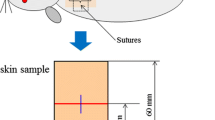Abstract
Laser tissue welding is a sutureless method of wound closure that has been used successfully in nerve, skin and arterial anastomoses. An elastin-based biomaterial patch was welded to the intimai surface of porcine aorta in the present study. The aorta was stained with indocyanine green dye to efficiently absorb the 808 nm diode laser light. Laser welding with a pulsed diode laser thermally confines heating to the stained portion of tissue, minimizing adjacent tissue damage. Laser welds of stained aorta to biomaterial were attempted by sandwiching the samples between glass slides and applying pressures ranging from 4 to 20 N cm-2 for 5 ms pulse durations and 83 mJ mm-2 radiant exposure. Bleaching of the indocyanine green by as much as 85% was observed after exposure laser irradiation. Finally, successful welds required 5 N cm-2 of pressure between the elastin biomaterial and aorta.
Similar content being viewed by others
References
Bass LS, Treat MR. Laser tissue welding: A comprehensive review of current future clinical applications.Lasers Surg Med 1996,17:315–49
Murray LW, Su L, Kopchok GE, White RA. Crosslinking of extracellular matrix proteins: a preliminary report on a possible mechanism of argon laser welding.Lasers Surg Med 1989,9:490–6
Chuck RS, Oz MC, Delohery TM et al. Dye-enhanced laser tissue welding.Lasers Surg Med 1989,9:471–7
Oz MC, Johnson JP, Parangi S et al. Tissue soldering by use of indocyanine green dye-enhanced fibrinogen with the near infrared diode laser.J Vasc Surg 1990,11:718–25
Anderson RR, Parrish JA. Microvasculature can be selective damaged using dye lasers: A basic theory and experimental evidence in human skin.Lasers Med Sci 1981,1:263–76
Rabaud M, Elie JY, Lefebvre F et al. A new biodegradable elastin-fibrin material; Its use in urological, digestive and cardiovascular surgery.J Biomat Appl 1992,7:20–46
Gregory KW, Grunkmeier JM. Internal elastic lamina replacement with a new elastin stent biomaterial.Circulation 1994,90:I596
Landsman MLJ, Kwant G, Mook GA, Zijlstra WG. Light-absorbing properties, stability, and spectral stabilization of indocyanine green.J Appl Physiol 1976,40:575–83
Bass LS, Libutti SK, Eaton AM. Tissue bonding and sealing composition and method of using the same.United States Patent 1993, 5.209,776
Prahl SA, Cheong WF, Yoon G, Welch AJ. Optical properties of human aorta during low power argon laser irradiation. In:SPIE Proceedings of Laser Interaction with Tissue 1988,908:29–33
Dimitrov D, Bass LS, Treat MR. Thermal breakdown properties of indocyanine green. In: Anderson RR (ed)SPIE Proceedings of Lasers in Surgery: Advanced Characterization, Therapeutics, and Systems V 1995, 2395:486–9
Gathje J, Steuer RR, Nicholes KRK. Stability studies on indocyanine green dye.J Appl Physiol 1970,29:181–5
Zhou JF, Chin MP, Schafer SA. Aggregation and degradation of indocyanine green. In: Anderson RR, Katzir A (eds)SPIE Proceedings in Laser Surgery: Advanced Characterization, Therapeutics, and Systems IV 1994, 2128:495–505
Author information
Authors and Affiliations
Rights and permissions
About this article
Cite this article
La Joie, E.N., Barofsky, A.D., Gregory, K.W. et al. Patch welding with a pulsed diode laser and indocyanine green. Laser Med Sci 12, 49–54 (1997). https://doi.org/10.1007/BF02763921
Received:
Accepted:
Issue Date:
DOI: https://doi.org/10.1007/BF02763921




